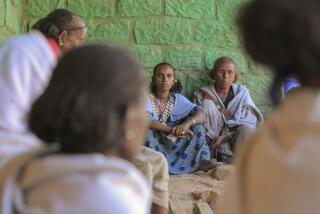Cautious Calm Spreads Westward From Somali Capital : Operations: U.S. soldiers gradually secure route to hinterlands, bringing new hope to despairing populace.
- Share via
BELA DOGLE, Somalia — Deep in the tangled bush of rural Somalia, the tanned airmen of Red Horse company, guarded by an Army Special Forces unit, were hard at work Saturday.
Maj. Ed Henson, the 37-year-old Air Force company leader, was crouched on an abandoned and long-forgotten 10,000-foot runway, testing its strength. One of his men, wearing a T-shirt and perched on a tractor, was carving wing-tip room from the thorny brush. Back in the gutted control tower, the centerpiece of this former air base, Army sentries with binoculars and high-powered rifles were covering Red Horse’s back.
This was the front Saturday of the U.S.-led military war on Somalia’s famine and disorder.
Just down the road were tens of thousands of reasons why American soldiers were resurrecting this airfield as a strategic new forward base.
One of them, Faduma, a 27-year-old widow, hadn’t eaten in four days. It had been that long since relief agencies stopped trying to make their way to a Red Cross feeding center up the bandit-controlled highway, 60 miles west of Mogadishu.
Faduma didn’t know when she and her three young children would eat again. And she had no idea whether her other two children were still alive. She was forced to leave them behind in the warring coastal town of Kismayu two years ago when armed men burst into her house, killed her husband, stole everything they owned and forced her to flee on foot.
Here, 300 miles away from Kismayu, she found no food. But, last week, she did find reason for hope.
“When we saw the American airplanes, we clapped so hard,” she said. “The looters take everything. Now, we hope, they are finished.”
This stretch of road, the lifeline to Baidoa, Bardera and many of the villages that have seen 300,000 die of hunger as Somalia’s clan war has raged on, runs through the heart of the nation’s nightmare.
Every few miles tells a story of how Somalia’s drought and war produced a famine and despair that required the unprecedented military force now beginning to fan out from new garrisons in the seaside capital, Mogadishu.
Operation Restore Hope, which began Wednesday, already has brought more than 2,000 American troops and the first semblance of order to Mogadishu.
Although Marine-escorted food shipments into the countryside won’t begin until more of the expected 28,000 soldiers arrive, a cautious sense of calm is spreading westward from the capital into areas where famine and the war still kill several hundred a day and threaten the lives of 2 million of Somalia’s 6 million people.
Well down the road from the military airfield at Bela Dogle, Khadija Osman, 40, held a small bowl of rice at a Red Cross feeding kitchen Saturday. A dirty dishcloth was draped over her head, and her emaciated 50-pound body was wrapped in a single gray sheet.
Osman arrived here three months ago from Baidoa--the center of Somalia’s famine, and center stage in its continuing clan warfare. She was driven away from her home after warring militiamen killed her cattle. During the family’s six-month journey to Afgoi, a village not far from here, six of her children, ages 9 to 15, starved to death.
“Child after child died,” she said, not even raising a hand to swat away a fly on her gaunt face. “It made me sick. I feel very sick.”
Now Osman, her husband and their surviving, 6-year-old daughter sleep on the streets. No one will take them in because their clan is different from the predominant clan in Afgoi.
Her husband begs on the streets, and Osman, when she isn’t too tired, asks for food at a Red Cross feeding kitchen, where up to 10 people die daily.
“Now that the Americans are here,” she said, “I hope everything will be all right.”
Evidence that a new era was beginning in Somalia was offered Saturday by Mayran Abdi. The sturdy Somali woman runs the famine relief center in Afgoi, one of dozens of villages where the gun is still the law.
The previous night, emboldened by the U.S. Marine presence in the distant capital, her staff finally decided to fight back against banditry.
When looters came to steal from her food stores, as they have done almost nightly for the last two years, her guards picked up their rifles and shot one dead. For the first time, she said, they were not afraid of revenge.
“We are happy the U.S. soldiers are here because finally we feel we will get security,” Abdi said.
The arrival of the new protectors has been felt in villages from Mogadishu to Bela Dogle. Guns are rarely seen, and although militia roadblocks are manned, cars are allowed to pass relatively freely.
Farther west, on the way to Baidoa, looting and armed robbery continue. But when the Marines move into Baidoa, which they are expected to do within a week, relief officials predict that also will end.
The famine has taken a devastating toll on Somalis. But here, at the Bela Dogle airstrip, on the U.S. military’s front line, it has left a lasting impression on men such as Maj. Henson.
Under Army guard, Henson and his Air Force construction crew of 11 had just finished testing the strength of the runway and taxiway Saturday afternoon. Although weeds are sprouting through the asphalt, the Air Force engineer figures it can support C-130s and maybe the larger C-141s.
The next step will be to establish a functioning control tower. The current tower, which five years ago oversaw joint U.S.-Somali military exercises, has been stripped of all its high-tech equipment and even its wires, most of which were installed by military engineers from the Soviet Union before ousted President Mohamed Siad Barre switched sides during the Cold War. The rusted remains of radios, circuit boards and radar units lay among the weeds three stories below.
“Everything was taken or thrown out the windows,” said Sgt. William Bell, of Lexington, Ky., who is part of the Army Special Forces unit that is providing security for the airmen.
Henson completed his assessment of the airstrip Saturday. Soon, planes will be landing there with troops and equipment to establish Operation Restore Hope’s first permanent presence outside Mogadishu. And later, the airport is likely to handle flights carrying relief food as well.
As he paused in the sun to reflect for a moment, Henson said he and his soldiers have reacted strongly to their firsthand view of the famine as part of the ongoing U.S. relief effort that has made 1,400 mercy flights to Somali cities since August.
While fortifying an airport for relief flights in Hoddur a few weeks ago, he watched a daily parade of bodies being taken from the relief agency feeding station on one side of the runway to the expanding cemetery on the other side.
“My whole team is pretty emotional about it,” said Henson, of Johnson City, Tenn. “But we figure if we can build up the airports to carry bigger grain flights, then we are helping.”
He said his entire crew has volunteered to extend its stay in Africa in hopes of making a difference in this country.
“It gets to you, though,” he added. “I don’t know if many of the guys would admit it. But I’ve got a 20-month-old daughter back home. . . . My wife is a (psychological) counselor. And I think she might have one extra patient when I get home.”
More to Read
Sign up for Essential California
The most important California stories and recommendations in your inbox every morning.
You may occasionally receive promotional content from the Los Angeles Times.











